NURS 4210 PH4001 The Role of the Nurse Leader in Population Health Assignment Pre-Assessment Paper Example
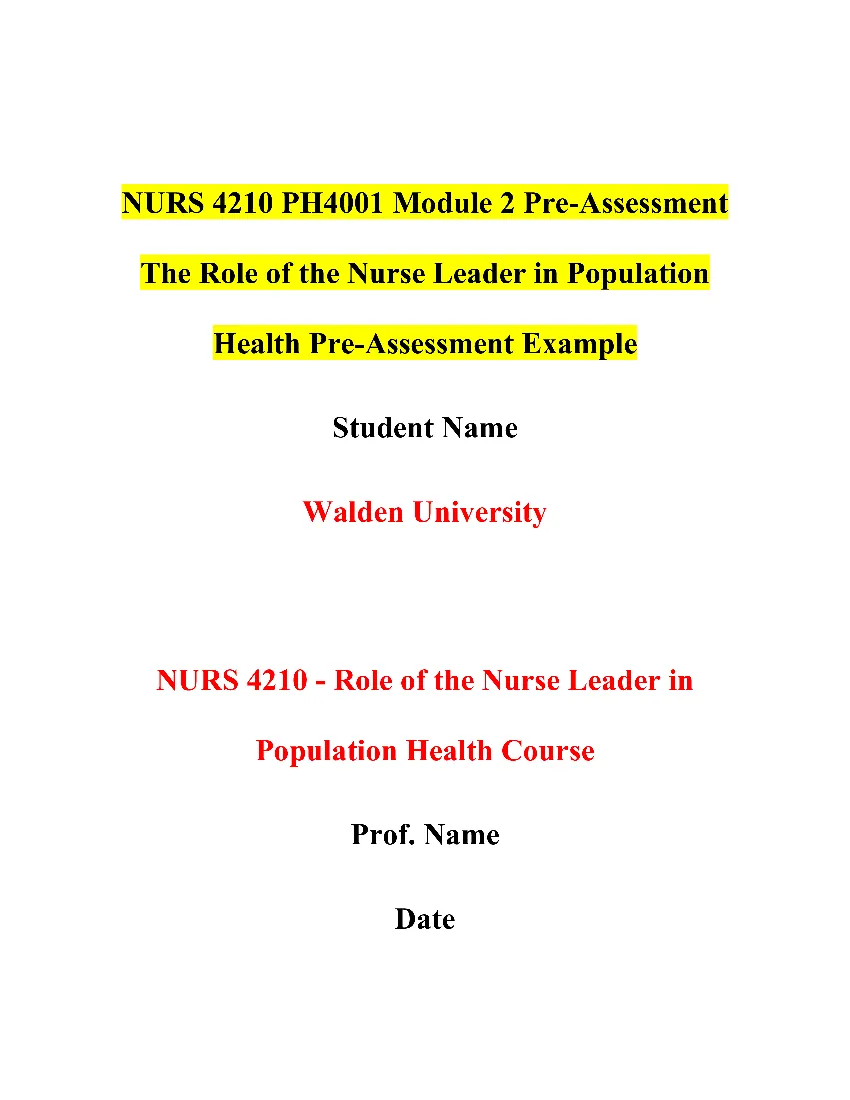 NURS 4210 PH4001 Module 2 Pre-Assessment The Role of the Nurse Leader in Population Health Pre-Assessment
NURS 4210 PH4001 Module 2 Pre-Assessment The Role of the Nurse Leader in Population Health Pre-Assessment
NURS 4210 PH4001 The Role of the Nurse Leader in Population Health Assignment Brief
Course: Role of the Nurse Leader in Population Health
Assignment Title: NURS 4210 PH4001 Module 2 Pre-Assessment The Role of the Nurse Leader in Population Health Pre-Assessment
Assignment Instructions Overview
This assignment focuses on analyzing the critical role of nurse leaders in population health. The module’s pre-assessment provides an opportunity to apply the content before the final Competency Assessment, which requires an audio recording submission. The pre-assessment can be crafted in various formats, including paragraph form, a script, or another type of deliverable to best suit the student’s needs. The responses should be well-supported by scholarly literature to demonstrate a thorough understanding of the concepts.
Understanding Assignment Objectives
The primary objective of this assignment is to explore and articulate the role of nurse leaders in the context of population health. Students will explain the concept of population health from a public health perspective, describe how public health nurses (PHNs) analyze and narrow down populations using various types of information, including social determinants of health, and compare the approaches of PHNs and hospital systems to population health. Through this exercise, students will enhance their understanding of how nurse leaders contribute to improving community health outcomes.
The Student’s Role
Students are expected to engage deeply with the material, demonstrating their ability to synthesize information from various sources and apply it to real-world scenarios. They will need to:
- Explain what is meant by “population health” from a public health perspective.
- Describe how a PHN analyzes and narrows down a population using different kinds of information, particularly social determinants of health.
- Compare and contrast the PHN’s approach to population health with that of a hospital system.
- The pre-assessment serves as a practice run, enabling students to refine their responses based on self-assessment and feedback before the final submission.
Competencies Measured
The assignment measures several key competencies:
- Understanding Population Health: Students must clearly and comprehensively explain the concept of population health, demonstrating an understanding of its significance in public health and how it encompasses the health outcomes of entire communities.
- Analytical Skills: Students must describe the process by which PHNs analyze and target populations. This includes the use of demographic, epidemiological, and social determinants of health data, showcasing their ability to integrate various information sources to identify and address health disparities.
- Comparative Analysis: Students must compare the PHN approach to population health with that of hospital systems. This requires an understanding of the different strategies and focuses of each approach, emphasizing prevention and community-based interventions versus clinical care and treatment.
You Can Also Check Other Related Assessments for the NURS 4210 – Role of the Nurse Leader in Population Health Course:
The Role of the Nurse Leader in Population Health Discussion Paper Example
PH4001 The Role of the Nurse Leader in Population Health Assignment Pre-Assessment Paper Example
Module 2 Pre-Assessment
Explain what is meant by the term “population health” from a public health perspective.
Population health, from a public health perspective, refers to the health outcomes of a group of individuals, including the distribution of such outcomes within the group. This concept extends beyond individual health and considers the broader determinants that influence health outcomes. According to the Centers for Medicare & Medicaid Services (CMS), population health encompasses health behaviors and outcomes of large groups, accounting for factors that influence the distribution of these outcomes (CMS, 2021). Population health seeks to improve the overall health of communities, regions, or countries by addressing a wide range of factors, including social determinants of health, which are conditions in the environments where people are born, live, learn, work, play, and age (Braveman & Gottlieb, 2014). These determinants include socioeconomic status, education, physical environment, employment, and social support networks, as well as access to healthcare.
Describe how a public health nurse (PHN) analyzes and narrows a population down using various kinds of information, including social determinants of health.
A Public Health Nurse (PHN) utilizes a systematic approach to analyze and narrow down a population for targeted health interventions. This process involves the collection and analysis of diverse data sets, including demographic, epidemiological, and social determinants of health data (Kulbok et al., 2012). Demographic data, such as age, gender, and ethnicity, provide insights into the population’s structure. Epidemiological data on disease prevalence and health behaviors help identify health priorities and risks within the community (Shi & Stevens, 2022).
PHNs place significant emphasis on social determinants of health, which include factors like income, education, employment, social support, and neighborhood conditions (Marmot & Wilkinson, 2005). By understanding these determinants, PHNs can identify vulnerable populations and health disparities. For instance, a community with high unemployment rates and limited access to nutritious food might be targeted for interventions addressing food insecurity and economic support (Robert Wood Johnson Foundation, 2011).
The PHN’s analysis involves community engagement and collaboration with local stakeholders to gather qualitative data, ensuring a comprehensive understanding of the population’s needs and resources. This holistic approach enables PHNs to design and implement effective, culturally sensitive interventions aimed at improving health outcomes and reducing health inequities.
Compare a PHN’s approach to population health with a hospital system’s approach to population health.
A Public Health Nurse (PHN) and a hospital system approach population health from different yet complementary perspectives.
PHN’s Approach
PHNs focus on community-based interventions and preventive care. Their approach is proactive, aiming to address the root causes of health issues by targeting social determinants of health (Bekemeier et al., 2019). PHNs work closely with community members, organizations, and local health departments to develop and implement public health programs. These programs might include vaccination campaigns, health education workshops, and initiatives to improve access to nutritious food and safe housing (American Public Health Association, 2013). The emphasis is on prevention, health promotion, and building community resilience (Institute of Medicine, 2012).
Hospital System’s Approach
Hospital systems, on the other hand, traditionally focus on individual patient care and treatment. Their approach to population health often involves managing chronic diseases, reducing hospital readmissions, and improving clinical outcomes (Berwick et al., 2008). Hospitals use data analytics to identify high-risk patients and implement care management programs to coordinate care and support. These programs might include follow-up care, patient education, and telehealth services (McCarthy et al., 2015). While hospitals are increasingly adopting population health strategies, their primary focus remains on clinical care and treatment.
Comparison
While both approaches aim to improve health outcomes, PHNs emphasize preventive measures and addressing social determinants, whereas hospitals focus more on clinical interventions and managing existing health conditions. The PHN’s approach is broader, targeting entire communities and aiming to prevent health issues before they arise. In contrast, the hospital system’s approach is narrower, concentrating on individual patients and providing treatment after health issues occur. Both approaches are essential for comprehensive population health management, with PHNs laying the groundwork for prevention and hospitals providing necessary medical care.
References
American Public Health Association. (2013). The role of public health nurses. Retrieved from https://www.apha.org
Bekemeier, B., Zahner, S. J., Kulbok, P. A., Merrill, J. A., & Kub, J. (2019). Assuring a strong foundation for our nation’s public health systems: An assessment of the Ten Essential Public Health Services and Agency Infrastructure. Public Health Nursing, 36(4), 396-406.
Berwick, D. M., Nolan, T. W., & Whittington, J. (2008). The triple aim: Care, health, and cost. Health Affairs, 27(3), 759-769.
Braveman, P., & Gottlieb, L. (2014). The social determinants of health: It’s time to consider the causes of the causes. Public Health Reports, 129(1_suppl2), 19-31.
Centers for Medicare & Medicaid Services (CMS). (2021). Population health. Retrieved from https://www.cms.gov
Institute of Medicine. (2012). For the public’s health: Investing in a healthier future. The National Academies Press.
Kulbok, P. A., Thatcher, E., Park, E., & Meszaros, P. (2012). Evolving public health nursing roles: Focus on community participatory health promotion and prevention. Online Journal of Issues in Nursing, 17(2), 1-13.
Marmot, M., & Wilkinson, R. G. (2005). Social determinants of health. OUP Oxford.
McCarthy, D., Radley, D., & Hayes, S. L. (2015). Aiming higher: Results from a scorecard on state health system performance. Commonwealth Fund.
Robert Wood Johnson Foundation. (2011). Health care’s blind side: The overlooked connection between social needs and good health. Retrieved from https://www.rwjf.org
Shi, L., & Stevens, G. D. (2022). Vulnerable populations in the United States. John Wiley & Sons.
Detailed Assessment Instructions for the NURS 4210 PH4001 The Role of the Nurse Leader in Population Health Assignment
Description
Module 2 Pre-Assessment
Module Pre-Assessments are your opportunity to practice applying module content before final submission of your Competency Assessment. Your final Competency Assessment submission is an audio recording. Therefore, you may choose to write your Pre-Assessment responses here in paragraph form, as a script, or as another type of deliverable. Consider what would be most helpful for you.
For your Module 2 Pre-Assessment, respond to the following prompts. These prompts match those in your final Assessment. Be sure to support your responses with evidence from scholarly literature.
Prompts:
- Explain what is meant by the term “population health” from a public health perspective.
- Describe how a public health nurse (PHN) analyzes and narrows a population down using various kind of information including social determinants of health.
- Compare a PHN’s approach to population health with a hospital system’s approach to population health
- https://www.england.nhs.uk/integratedcare/what-is-…
- https://cdn.ymaws.com/www.safestates.org/resource/…
Once you submit your response, use the rubric to ensure that you have met all requirements and are satisfied with your submission. Use your self-assessment submission and any feedback you may garner to improve and refine your responses. Note that you do not need to resubmit your Self-Assessment to address feedback.
Use the following rubric to assess your responses.
Rubric Criteria Does Not Meet Expectations Meets Expectations Exceeds Expectations Explain what is meant by the term “population health” from a public health perspective. Learning Objective 2.1: Analyze population health Response does not adequately explain what is meant by the term “population health” from a public health perspective. Response adequately explains what is meant by the term “population health” from a public health perspective. Response clearly and completely explains what is meant by the term “population health” from a public health perspective. Rubric Criteria Does Not Meet Expectations Meets Expectations Exceeds Expectations from a public health perspective Describe how a public health nurse (PHN) analyzes and narrows a population down using various kind of information including social determinants of health. Learning Objective 2.2: Describe the process of targeting populations from a public health nursing perspective Response does not adequately describe how a public health nurse analyzes and narrows a population down using various kinds of information including social determinants of health. Response adequately describes how a public health nurse analyzes and narrows a population down using various kinds of information including social determinants of health. Response clearly and completely describes how a public health nurse analyzes and narrows a population down using various kinds of information including social determinants of health. Compare a PHN’s approach to population health with a hospital system’s approach to population health. Learning Objective 2.3: Compare the PHN approach to population health with the hospital system approach to population health Response does not adequately compare a PHN’s approach to population health with a hospital system’s approach to population health. Response adequately compares a PHN’s approach to population health with a hospital system’s approach to population health. Response clearly and completely compares a PHN’s approach to population health with a hospital system’s approach to population health.
Make Your Nursing Academic Journey Truly Fulfilling with Our Expert Nursing Assignment Writing Help!
Feeling overwhelmed by the demands of your nursing essays and assignments? Don’t let stress derail your academic success. NursingCustomWriting.com is your partner in navigating the challenges of nursing studies. Our reliable nursing paper writing services are tailored to lighten your assignment load and ensure your journey in nursing education is not just manageable, but truly fulfilling.
Expertise That Sets Us Apart
At NursingCustomWriting.com, we understand the unique struggles faced by nursing students. That’s why we’ve assembled a team of seasoned nursing writers who are not only experts in their field but also passionate about helping students succeed. Our writers bring years of academic writing experience and a deep understanding of nursing topics, ensuring that your papers are meticulously crafted to meet the highest standards.
Why Choose NursingCustomWriting.com for Your Nursing Essays?
- Experienced Nursing Writers: Our team comprises experienced nursing professionals who are dedicated to delivering top-quality nursing papers tailored to your requirements.
- Direct Communication: You’ll have direct communication with your assigned writer, allowing for seamless collaboration and transparency throughout the writing process.
- Affordable Prices: We understand the financial constraints of students, which is why we offer competitive prices starting at just $10 per page.
- Guaranteed Originality: Plagiarism is a strict no-no at NursingCustomWriting.com. We guarantee 100% original, custom-made papers that reflect your unique voice and understanding.
- Timely Support: With our fast turnaround times and dedicated support team, you can rest assured that your papers will be delivered on time, every time.
- Hassle-Free Ordering: Ordering a custom nursing paper from NursingCustomWriting.com is quick and easy. Simply provide your details, and our experts will take care of the rest.
Why Struggle When Help Is Just a Click Away?
Don’t let nursing assignments overwhelm you. With NursingCustomWriting.com’s nursing writing help services, you can reclaim your time, achieve top grades, and stay ahead of the curve. Order your custom nursing paper today and unlock your full potential with NursingCustomWriting.com!
Don’t Let Stress Define Your Nursing Academic Journey
Place your order with NursingCustomWriting.com today and experience the difference firsthand. Whether you need to buy nursing research papers, get cheap nursing papers, or professional nursing coursework help, we’ve got you covered. Trust us with your nursing assignments, and let us help you succeed in your nursing studies.


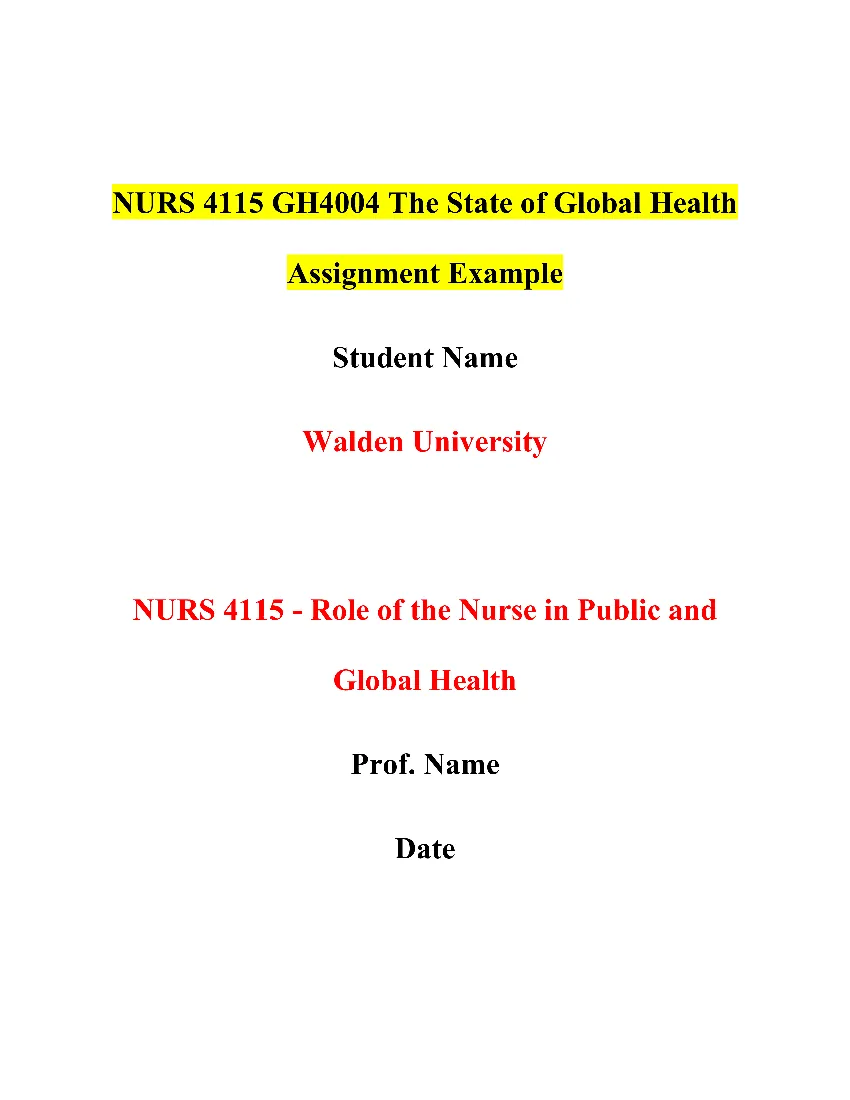 NURS 4115 GH4004 The State of Global Health Assignment
NURS 4115 GH4004 The State of Global Health Assignment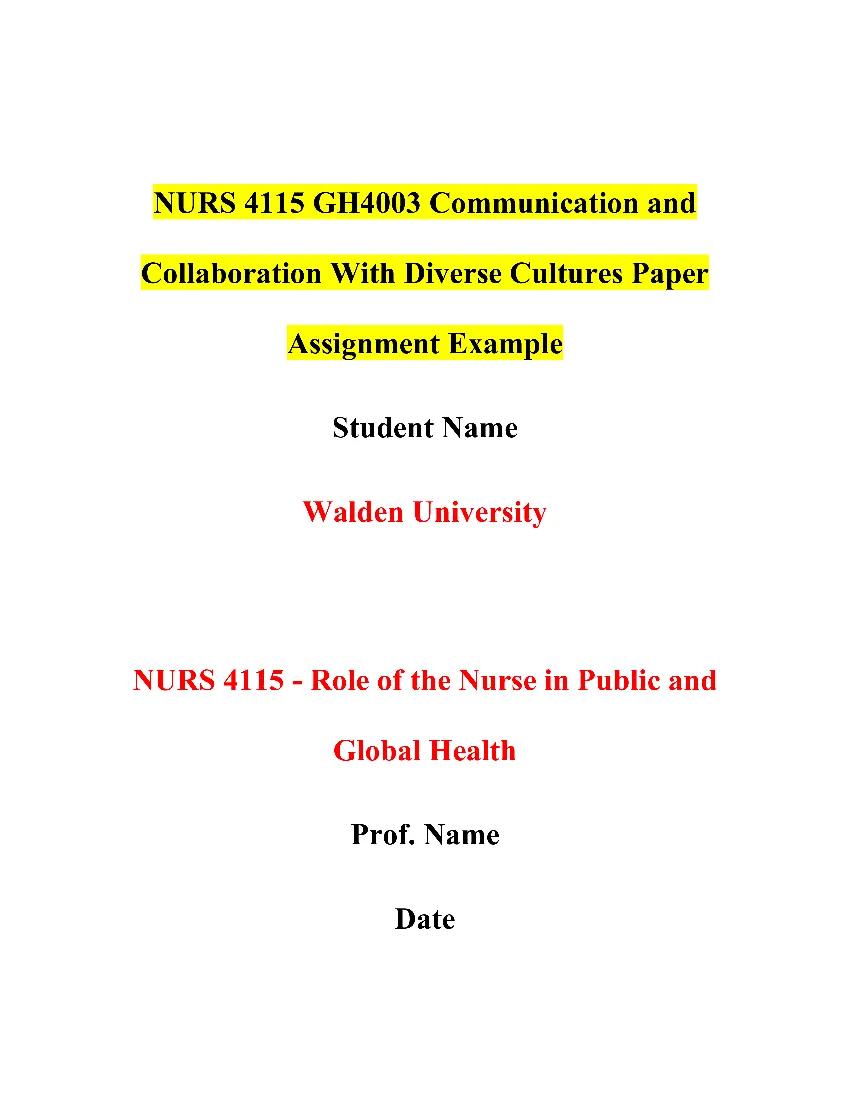 NURS 4115 GH4003 Communication and Collaboration With Diverse Cultures Paper Assignment
NURS 4115 GH4003 Communication and Collaboration With Diverse Cultures Paper Assignment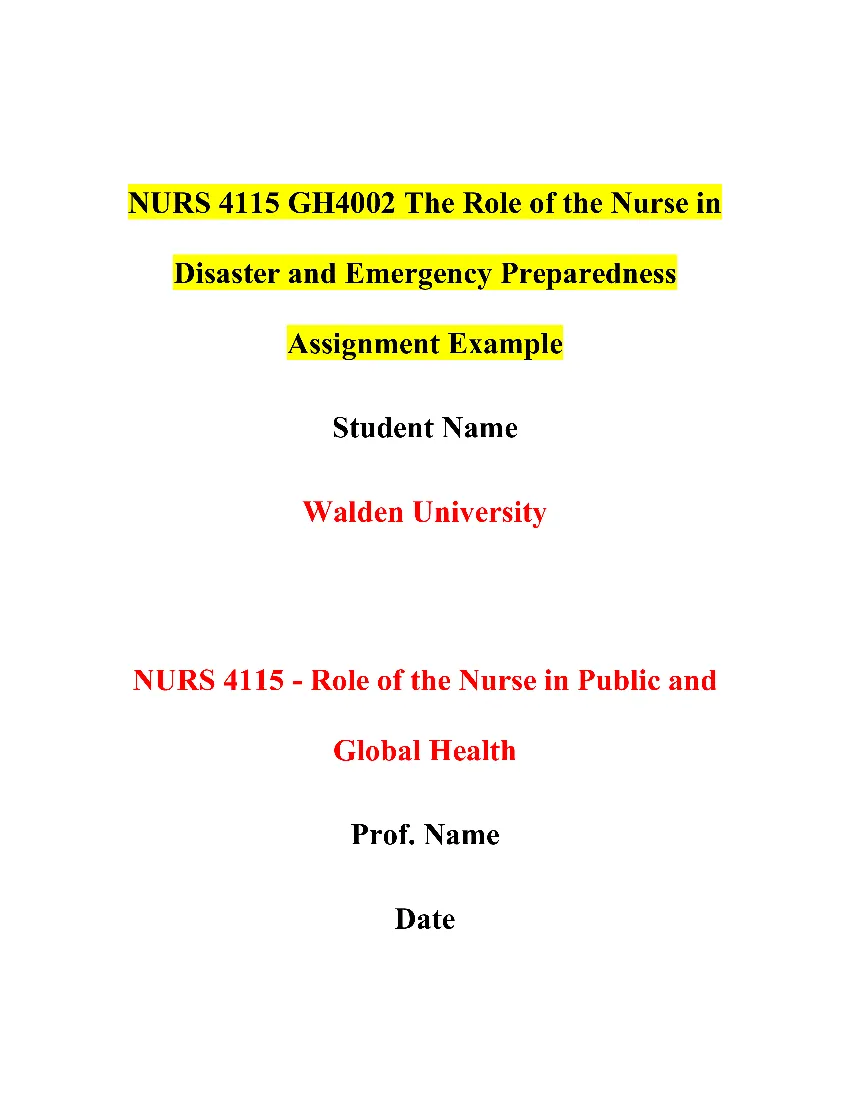 NURS 4115 GH4002 The Role of the Nurse in Disaster and Emergency Preparedness Assignment
NURS 4115 GH4002 The Role of the Nurse in Disaster and Emergency Preparedness Assignment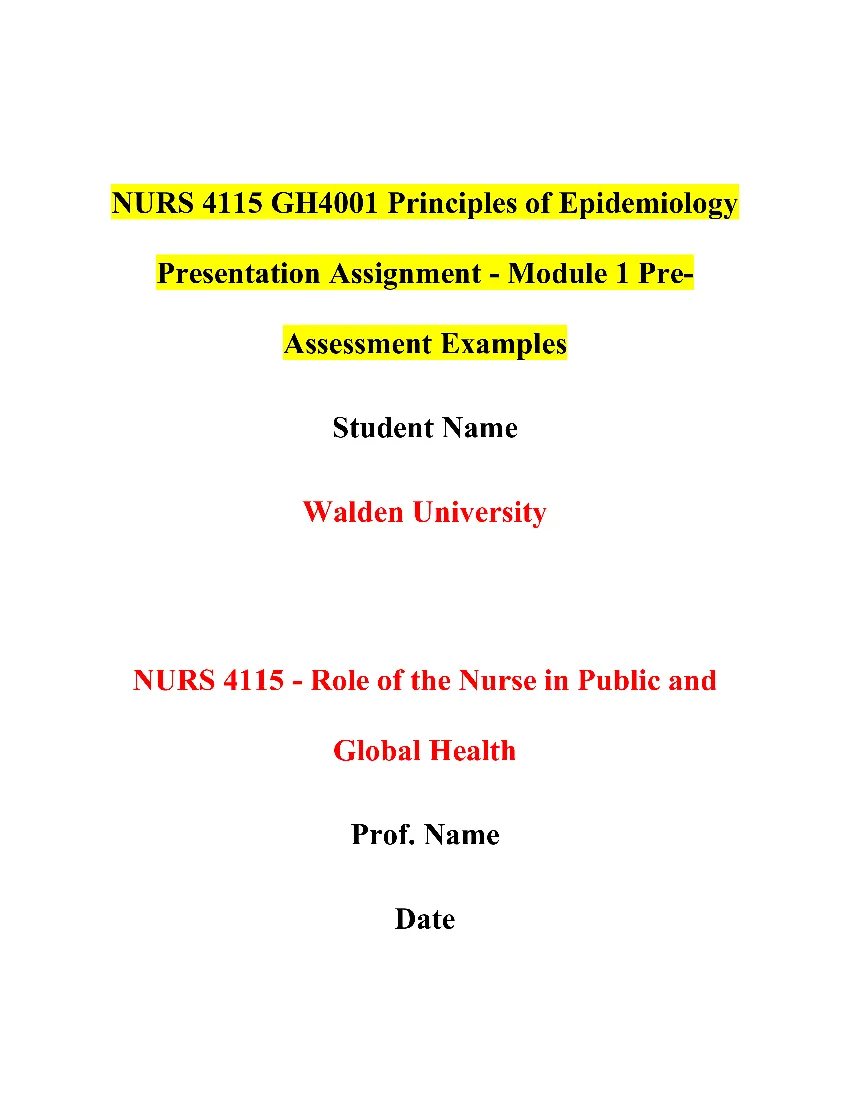 NURS 4115 GH4001 Principles of Epidemiology Presentation Assignment – Module 1 Pre-Assessment
NURS 4115 GH4001 Principles of Epidemiology Presentation Assignment – Module 1 Pre-Assessment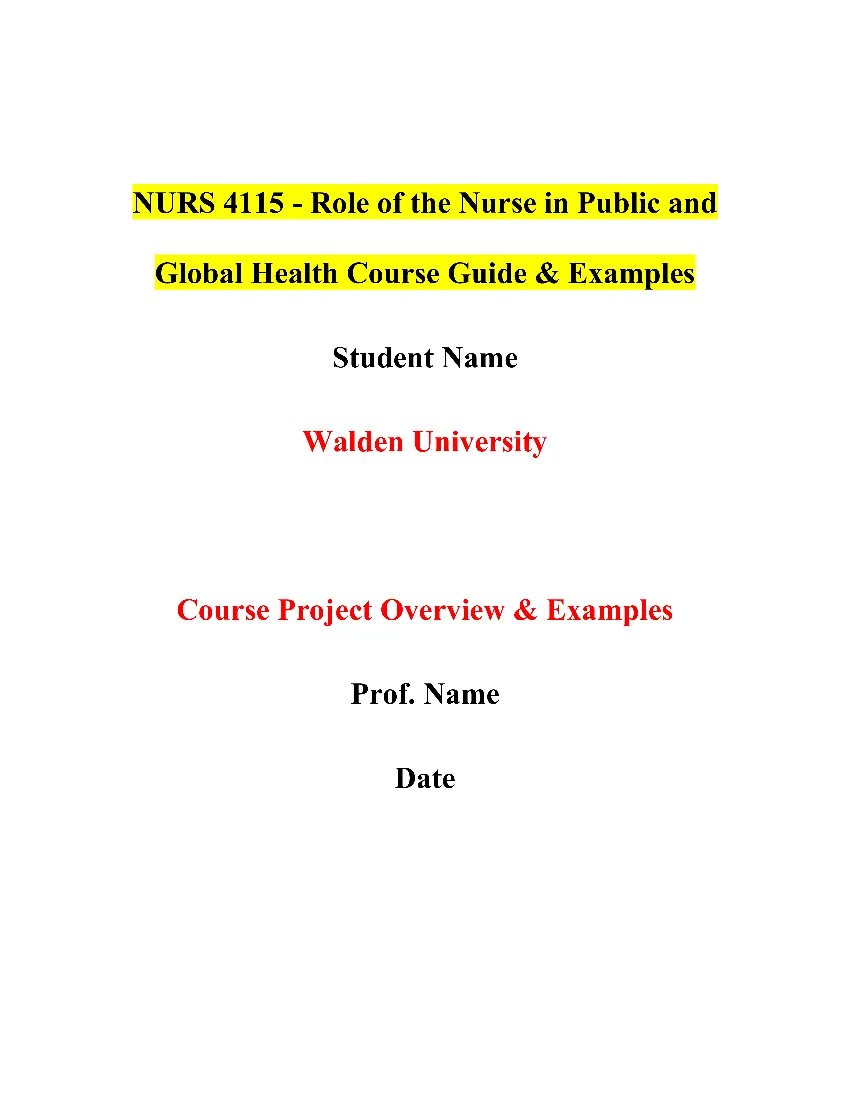 NURS 4115 – Role of the Nurse in Public and Global Health Course Guide & Examples
NURS 4115 – Role of the Nurse in Public and Global Health Course Guide & Examples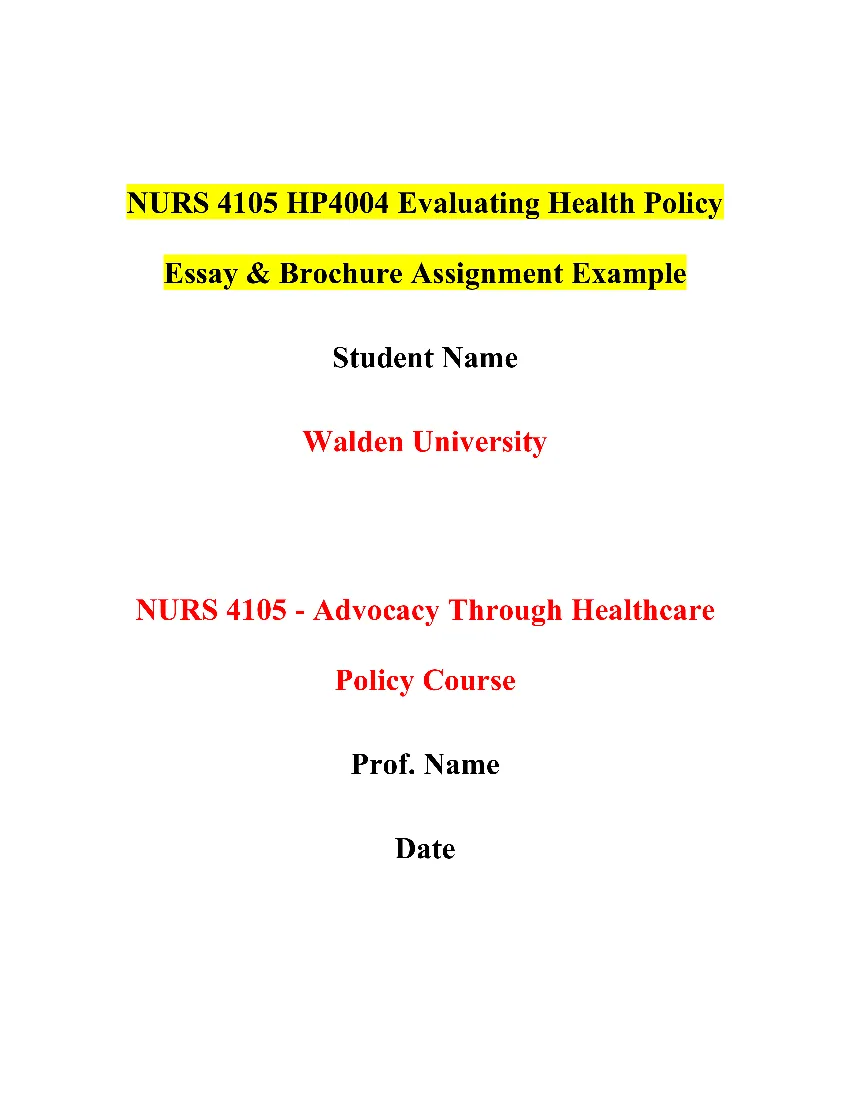 NURS 4105 HP4004 Evaluating Health Policy Essay & Brochure Assignment
NURS 4105 HP4004 Evaluating Health Policy Essay & Brochure Assignment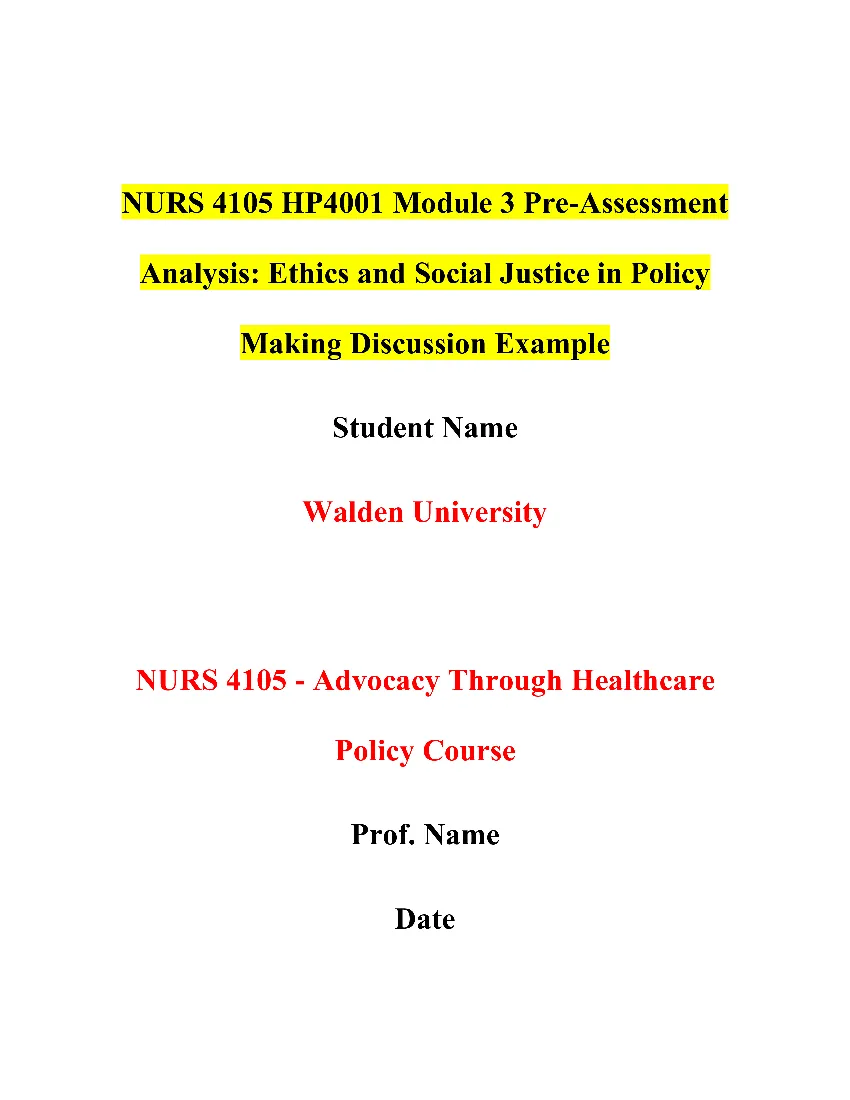 NURS 4105 HP4001 Module 3 Pre-Assessment Analysis: Ethics and Social Justice in Policy Making Discussion
NURS 4105 HP4001 Module 3 Pre-Assessment Analysis: Ethics and Social Justice in Policy Making Discussion NURS 4100 EP4001 Iowa Model of Evidence Based Practice Models for Research Paper Assignment
NURS 4100 EP4001 Iowa Model of Evidence Based Practice Models for Research Paper Assignment